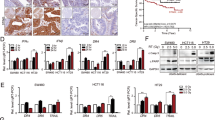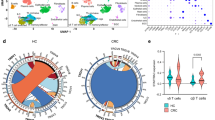Abstract
Blockade of the PD-1/PD-L1 axis has demonstrated remarkable success in treating colorectal cancer (CRC) with high microsatellite instability (MSI-H). However, the metastatic CRC with microsatellite stability (MSS) does not respond to this approach. A recent study revealed that rare neoantigens in MSS-type CRC cells can be recognized by antigen-specific CD8+ T cells but not by dendritic cells (DCs). Thus, increasing neoantigen availability by DCs may improve the efficacy of PD-1/PD-L1 inhibitors in MSS-type CRC. Here, we conducted a drug library screening for ‘eat me’ signal, represented by cell surface calreticulin (CRT) exposure, in MSS-type CT26 cells. Cells treated with identified cepharanthine (CEP) presented hallmarks of immunogenic cell death (ICD), characterized by increased cell surface CRT exposure, the release of HMGB1 and ATP, increased susceptibility to phagocytosis, and the ability of vaccines to elicit immunogenic potential in vivo. Mechanistically, CEP blocked autophagic flux by inhibiting autophagsome-lysosome fusion, leading to endoplasmic reticulum (ER) stress and ICD activation. Moreover, CEP upregulated PD-L1 expression on tumour cells, impeding the antitumour immune response in vivo. The combination of CEP and anti-PD-1 therapy provided therapeutic benefit to MSS-type CRC tumours, with an increased proportion of activated DCs and IFNγ+ CD8+ T cells and a decreased proportion of regulatory T cells within the tumour. Based on the above observation, subsequent clinical trials can be conducted to achieve the clinical goal of increasing the survival benefit of MSS-CRC patients.
This is a preview of subscription content, access via your institution
Access options
Subscribe to this journal
Receive 50 print issues and online access
$259.00 per year
only $5.18 per issue
Buy this article
- Purchase on SpringerLink
- Instant access to full article PDF
Prices may be subject to local taxes which are calculated during checkout








Similar content being viewed by others
Data availability
On reasonable request to the corresponding author.
References
Cohen R, Rousseau B, Vidal J, Colle R, Diaz LA Jr, André T. Immune checkpoint inhibition in colorectal cancer: microsatellite instability and beyond. Target Oncol. 2020;15:11–24.
Wang F, Wang ZX, Chen G, Luo HY, Zhang DS, Qiu MZ, et al. Expert opinions on immunotherapy for patients with colorectal cancer. Cancer Commun. 2020;40:467–72.
De’ Angelis GL, Bottarelli L, Azzoni C, De’ Angelis N, Leandro G, Di Mario F, et al. Microsatellite instability in colorectal cancer. Acta Biomed. 2018;89:97–101.
Yao YC, Jin Y, Lei XF, Wang ZX, Zhang DS, Wang FH, et al. Impact of mismatch repair or microsatellite status on the prognosis and efficacy to chemotherapy in metastatic colorectal cancer patients: A bi-institutional, propensity score-matched study. J Cancer. 2022;13:2912–21.
Jan YH, Tan KT, Chen SJ, Yip TTC, Lu CT, Lam AK. Comprehensive assessment of actionable genomic alterations in primary colorectal carcinoma using targeted next-generation sequencing. Br J Cancer. 2022;127:1304–11.
Westcott PMK, Sacks NJ, Schenkel JM, Ely ZA, Smith O, Hauck H, et al. Low neoantigen expression and poor T-cell priming underlie early immune escape in colorectal cancer. Nat Cancer. 2021;2:1071–85.
Arimoto KI, Miyauchi S, Liu M, Zhang DE. Emerging role of immunogenic cell death in cancer immunotherapy. Front Immunol. 2024;15:1390263.
Qian ZY, Pan YQ, Li XX, Chen YX, Wu HX, Liu ZX, et al. Modulator of TMB-associated immune infiltration (MOTIF) predicts immunotherapy response and guides combination therapy. Sci Bull. 2024;69:803–22.
Motzer RJ, Escudier B, McDermott DF, George S, Hammers HJ, Srinivas S, et al. Nivolumab versus everolimus in advanced renal-cell carcinoma. N Engl J Med. 2015;373:1803–13.
Yarchoan M, Johnson BA 3rd, Lutz ER, Laheru DA, Jaffee EM. Targeting neoantigens to augment antitumour immunity. Nat Rev Cancer. 2017;17:209–22.
Schumacher TN, Schreiber RD. Neoantigens in cancer immunotherapy. Science. 2015;348:69–74.
Network CGA. Comprehensive molecular characterization of human colon and rectal cancer. Nature. 2012;487:330–7.
Guinney J, Dienstmann R, Wang X, de Reyniès A, Schlicker A, Soneson C, et al. The consensus molecular subtypes of colorectal cancer. Nat Med. 2015;21:1350–6.
Roelands J, Kuppen PJK, Vermeulen L, Maccalli C, Decock J, Wang E, et al. Immunogenomic classification of colorectal cancer and therapeutic implications. Int J Mol Sci. 2017;18:2229.
Kroemer G, Galluzzi L, Kepp O, Zitvogel L. Immunogenic cell death in cancer therapy. Annu Rev Immunol. 2013;31:51–72.
Medina CB, Ravichandran KS. Do not let death do us part: ‘find-me’ signals in communication between dying cells and the phagocytes. Cell Death Differ. 2016;23:979–89.
Garg AD, Martin S, Golab J, Agostinis P. Danger signalling during cancer cell death: origins, plasticity and regulation. Cell Death Differ. 2014;21:26–38.
Huang H, Hu G, Wang C, Xu H, Chen X, Qian A. Cepharanthine, an alkaloid from Stephania cepharantha Hayata, inhibits the inflammatory response in the RAW264.7 cell and mouse models. Inflammation. 2014;37:235–46.
Kanamori S, Hiraoka M, Fukuhara N, Oizumi Y, Danjo A, Nakata K, et al. Clinical efficacy of cepharanthin(R)for radiotherapy-induced leukopenia - a nationwide, multicenter, and observational study]. Gan Kagaku Ryoho. 2016;43:1075–9.
Liang D, Li Q, Du L, Dou G. Pharmacological effects and clinical prospects of cepharanthine. Molecules. 2022;27:8933.
Lu YY, Zhu CY, Ding YX, Wang B, Zhao SF, Lv J, et al. Cepharanthine, a regulator of keap1-Nrf2, inhibits gastric cancer growth through oxidative stress and energy metabolism pathway. Cell Death Discov. 2023;9:450.
Rattanawong A, Payon V, Limpanasittikul W, Boonkrai C, Mutirangura A, Wonganan P. Cepharanthine exhibits a potent anticancer activity in p53-mutated colorectal cancer cells through upregulation of p21Waf1/Cip1. Oncol Rep. 2018;39:227–38.
Liu B, Deng JX. Effect of cepharanthine on the stemness of lung squamous cell carcinoma based on network pharmacology and bioinformatics. Biomed Res Int. 2022;2022:5956526.
Cong L, Ran FA, Cox D, Lin S, Barretto R, Habib N, et al. Multiplex genome engineering using CRISPR/Cas systems. Science. 2013;339:819–23.
Eisenbarth SC. Dendritic cell subsets in T cell programming: location dictates function. Nat Rev Immunol. 2019;19:89–103.
Iulianna T, Kuldeep N, Eric F. The Achilles’ heel of cancer: targeting tumors via lysosome-induced immunogenic cell death. Cell Death Dis. 2022;13:509.
Santana-Codina N, Mancias JD, Kimmelman AC. The role of autophagy in cancer. Annu Rev Cancer Biol. 2017;1:19–39.
Zitvogel L, Kepp O, Senovilla L, Menger L, Chaput N, Kroemer G. Immunogenic tumor cell death for optimal anticancer therapy: the calreticulin exposure pathway. Clin Cancer Res. 2010;16:3100–4.
Kapuy O. Mechanism of decision making between autophagy and apoptosis induction upon endoplasmic reticulum stress. Int J Mol Sci. 2024;25:4368.
Fucikova J, Kepp O, Kasikova L, Petroni G, Yamazaki T, Liu P, et al. Detection of immunogenic cell death and its relevance for cancer therapy. Cell Death Dis. 2020;11:1013.
Kroemer G, Galassi C, Zitvogel L, Galluzzi L. Immunogenic cell stress and death. Nat Immunol. 2022;23:487–500.
Herbst RS, Soria JC, Kowanetz M, Fine GD, Hamid O, Gordon MS, et al. Predictive correlates of response to the anti-PD-L1 antibody MPDL3280A in cancer patients. Nature. 2014;515:563–7.
Rizvi NA, Hellmann MD, Snyder A, Kvistborg P, Makarov V, Havel JJ, et al. Cancer immunology. Mutational landscape determines sensitivity to PD-1 blockade in non-small cell lung cancer. Science. 2015;348:124–8.
Fucikova J, Becht E, Iribarren K, Goc J, Remark R, Damotte D, et al. Calreticulin expression in human non-small cell lung cancers correlates with increased accumulation of antitumor immune cells and favorable prognosis. Cancer Res. 2016;76:1746–56.
Ladoire S, Penault-Llorca F, Senovilla L, Dalban C, Enot D, Locher C, et al. Combined evaluation of LC3B puncta and HMGB1 expression predicts residual risk of relapse after adjuvant chemotherapy in breast cancer. Autophagy. 2015;11:1878–90.
Knox T, Sahakian E, Banik D, Hadley M, Palmer E, Noonepalle S, et al. Selective HDAC6 inhibitors improve anti-PD-1 immune checkpoint blockade therapy by decreasing the anti-inflammatory phenotype of macrophages and down-regulation of immunosuppressive proteins in tumor cells. Sci Rep. 2019;9:6136.
Xiao WW, Chen G, Gao YH, Lin JZ, Wu XJ, Luo HL, et al. Effect of neoadjuvant chemoradiotherapy with or without PD-1 antibody sintilimab in pMMR locally advanced rectal cancer: a randomized clinical trial. Cancer Cell. 2024;42:1570–1581.e1574.
Chen H, Yu S, Ma R, Deng L, Yi Y, Niu M, et al. Hypoxia-activated XBP1s recruits HDAC2-EZH2 to engage epigenetic suppression of ΔNp63α expression and promote breast cancer metastasis independent of HIF1α. Cell Death Differ. 2024;31:447–59.
Li DD, Xie B, Wu XJ, Li JJ, Ding Y, Wen XZ, et al. Late-stage inhibition of autophagy enhances calreticulin surface exposure. Oncotarget. 2016;7:80842–54.
Shingu T, Fujiwara K, Bögler O, Akiyama Y, Moritake K, Shinojima N, et al. Stage-specific effect of inhibition of autophagy on chemotherapy-induced cytotoxicity. Autophagy. 2009;5:537–9.
Michaud M, Martins I, Sukkurwala AQ, Adjemian S, Ma Y, Pellegatti P, et al. Autophagy-dependent anticancer immune responses induced by chemotherapeutic agents in mice. Science. 2011;334:1573–7.
Nomoto S, Imada H, Ohguri T, Yahara K, Kato F, Morioka T, et al. Effect of Cepharanthin in preventing radiation induced normal tissue damage in prostate cancer]. Gan Kagaku Ryoho. 2004;31:1063–6.
Paladhi A, Daripa S, Mondal I, Hira SK. Targeting thymidine phosphorylase alleviates resistance to dendritic cell immunotherapy in colorectal cancer and promotes antitumor immunity. Front Immunol. 2022;13:988071.
Acknowledgements
We thank the members of the C.Xu laboratories for their helpful advice and discussion.
Funding
This work was supported by the special key projects for Natural Science Foundation of Chongqing (2024NSCQ-KJFZMSX0220), the Scientific Research Grant of Chengdu Municipal Health Commission (2022099), the Medical Research Project of Sichuan Province (Q22011) granted to MZ, and the National Key R&D Programme of China (Grant No. 2023YFC3402100), National Natural Science Foundation of China (Grant No. 92259102), Sichuan Natural Science Foundation of China (Grant No. 2024NSFSC0057), and Chongqing Science and Technology Bureau (Grant No. CSTB2024TIAD-KPX0029) to CX.
Author information
Authors and Affiliations
Contributions
MZ and CX conceptualised and designed the experiment. MZ, JN, ZYY, XML, AY, and CL carried out the experiment. RYZ and XML participated in the data collection. MZ, RYZ, and JL helped data analysis. CX revised the manuscript.
Corresponding author
Ethics declarations
Competing interests
The authors declare no competing interests.
Ethical approval
All methods were performed in accordance with the relevant guidelines and regulations. The mouse experiment was approved by the Animal Welfare Ethics Committee at Chengdu Medical College (IACUC-24-034).
Additional information
Publisher’s note Springer Nature remains neutral with regard to jurisdictional claims in published maps and institutional affiliations.
Supplementary information
Rights and permissions
Springer Nature or its licensor (e.g. a society or other partner) holds exclusive rights to this article under a publishing agreement with the author(s) or other rightsholder(s); author self-archiving of the accepted manuscript version of this article is solely governed by the terms of such publishing agreement and applicable law.
About this article
Cite this article
Zhao, M., Nie, J., Ye, A. et al. Impaired autophagy by cepharanthine induces immunogenic cell death and enhances anti-PD-1 response in MSS-type colorectal cancer. Oncogene 44, 3171–3182 (2025). https://doi.org/10.1038/s41388-025-03488-9
Received:
Revised:
Accepted:
Published:
Issue date:
DOI: https://doi.org/10.1038/s41388-025-03488-9



